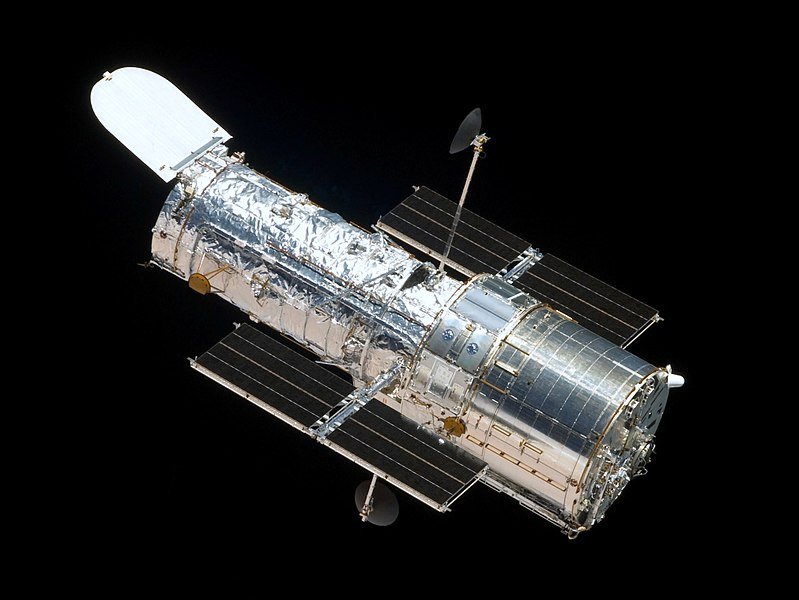Today we celebrate Hubble Space Telescope’s 28th Birthday! On April 24, 1990 Hubble was launched into space aboard Space Shuttle Discovery. Today, 28 years and 5 crewed servicing missions later, the telescope is still working hard, uncovering mysteries of the Universe. Hubble’s data and pictures encouraged many people to study Astronomy and led to publications of thousands of scientific papers. One discovery made with Hubble was even awarded a Nobel Prize in 2011!
Edwin Hubble
Hubble Space Telescope (HST) was named after an American Astronomer Edwin Hubble. Edwin Hubble was the first to figure out that there are other galaxies outside our Milky Way (the idea that was laughed at by many of his colleagues). He also offered a simple and convenient way to classify galaxies by the way they look, we call it “Hubble tuning fork”. Astronomer still use this classification today. But most of us associate the scientist’s name with the “Hubble’s Law”. This law states, in simple terms, that the Universe expands, and the further the object is from us, the faster it recedes. Strictly speaking, Edwin Hubble was not the first to propose the idea, but his observations allowed to estimate the rate of the expansion, or hubble’s constant.
Space Telescopes
In 1946 an American Astrophysicists Lyman Spitzer Jr. published a paper called “Astronomical advantages of an extra-terrestrial observatory”. Spitzer promoted the idea of space telescope all his life and his efforts eventually led to construction of HST.
In the seventies NASA (American Space Agency) and ESA (European Space Agency) joined forces to build a space telescope. It took nearly 15 years to complete and launch the project, the Hubble Space Telescope.
After the launch
If you think that this is when the glorious story of Hubble’s successful research starts, you are very much mistaken. When the telescope was finally launched and deployed in 1990, scientists were up for a disappointment. Hubble’s images were blurry! Due to manufacturing error the mirror was a slightly wrong shape! NASA scientists figured out what the problem was and in December 1993 the first servicing mission successfully performed repairs of the main mirror. Just after the New Year in 1994 HST finally sent the first beautiful images back to Earth and the observatory was finally up and running!
Five scheduled servicing missions in total were successfully completed between 1993 and 2009. The last mission installed the system that will allow us to deorbit Hubble at the end of its life, somewhere between 2020 and 2030.
Hubble facts
- The telescope is about 13.2 m long and 4.2 m wide. The diameter of its big mirror is 2.4 m.
- HST orbits the Earth at an Altitude of 340 miles (547 kilometers). The observatory completes one orbit in 95 minutes.
- The telescope can see infrared, visible, and ultraviolet light.
Hubble’s main discoveries
Hubble studies a variety of targets, from planets, moons and Kuiper Belt objects in our own Solar System, to black holes and early galaxies. Here are just a few things that we learned thanks to Hubble:
- The value of “hubble’s constant” and therefore the age of the Universe. Our Universe is 13.8 billion years old!
- The Universe is not just expanding, but the rate of expansion is accelerating.
- Black holes (including the supermassive ones)! There are supermassive black holes in the centers of maybe even all galaxies. Moreover, it looks like the bigger the galaxy, the bigger the black hole in the centre.
- Kuiper Belt objects! Hubble spotted many Kuiper Belt objects, including moons of dwarf planets Pluto and Makemake.
- Young galaxies! It takes light a long time to travel through space. The further into space we look, the younger objects we see. What we see with the telescope is not how the object looks now, but how it used to look like when the light that we caught was emitted by the object! The light from the farthest individual star Icarus, spotted by HST traveled 9 billion years to reach the telescope. The farthest galaxy the telescope can see is 13.4 light years away.
- Exoplanets! Kepler Space Telescope is a telescope specially designed to look for planets orbiting other stars. Ground-based telescopes help Kepler do the job. Hubble is on the team too!
Happy Birthday from our space dome team, Hubble Space Telescope! Many happy returns of the day!
Any questions?
Visit NASA Hubble homepage to learn more about the Hubble mission.
Visit our portable planetarium to learn more about the Solar System and beyond, space exploration and search for life outside the Earth.

